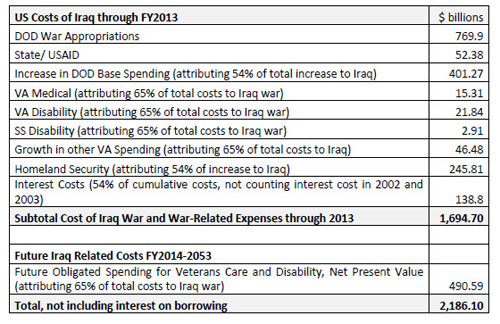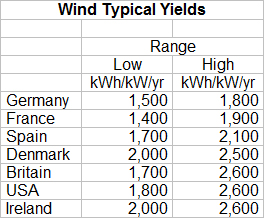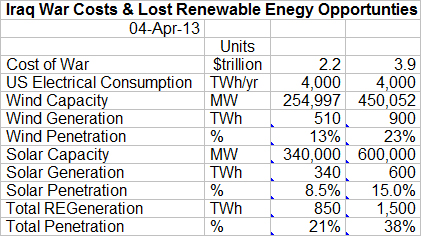The Iraq War and Renewable Energy
For the Amount Spent on the Iraq War the US Could be Generating 40% to 60% of its Electricity with Renewable Energy
April 8, 2013
Paul Gipe
The US is noting a somber milestone this year: a decade of death and destruction following its invasion of Iraq.
As the country continues struggling with the moral dimension of its action, what has become clear is the staggering cost to future Americans and the opportunities forsaken here at home.
For it is future Americans who will pay for our rush to war—a war that was financed with debt. And it is this enormous debt that has laid siege not to Baghdad but to Washington, DC, where Austerians shout that the nation can no longer afford to rebuild our crumbling infrastructure because of the mounting interest on this debt.
On 4 July 2005, I posted the first in a series of articles on the lost opportunity for the massive development of sources of energy in the US--lost because of our invasion of Iraq. See Beating Swords into Wind Turbines–or Solar Panels if You Like. The money we spent--or the debt we incurred--for war was money we would not invest in our own country to make the transition to a renewable future.
Now, after a decade, that bill has come due. What have we lost? What have we forsaken?
Disregarding the human cost, and disregarding our “other” war in Afghanistan, how much renewable energy could we have built with the money we spent? How far along the road toward the renewable energy transition could we have traveled?
The answer: shockingly far.
Cost of the Iraq War
The war in Iraq has cost $1.7 trillion through fiscal year 2013, according to Brown University’s Watson Institute for International Studies. That’s trillion, with a “t”. Including future costs for veteran’s care, and so on, raises the cost to $2.2 trillion.

Because the war was financed with debt, we should also include a charge for interest on the debt. The Iraq war’s share of cumulative interest on the US debt through 2053 will raise the total cost of the war to $3.9 trillion.
To weigh what opportunities we lost, we’ll consider two conditions: the direct cost, and the direct cost plus interest.
Renewable Energy Assumptions
In my previous assessments, I considered only wind or only solar. For this evaluation, I will use a mix of wind and solar.
Why a mix? Because if we want to develop an integrated system that will replace the mix of fossil fuels and nuclear power we use today, we will need a mix of renewable resources as well. Ideally, we would develop our wind, solar, geothermal, and biomass resources simultaneously. However, it is wind and solar that will provide the bulk of new generating capacity. So I’ve simplified this analysis by only considering a mix of wind and solar.
What should that mix look like? Research by French renewable authority Bernard Chabot concludes that the optimum mix requires that 60% of the generation—not of the capacity—must be from wind, and 40% of the generation from solar. Recent studies in Germany and Australia have confirmed Chabot’s work.
While the cost of solar has declined dramatically, it remains far more expensive than wind generation. Including solar as part of a mix of resources reduces the effective penetration of renewables, but is more realistic and, hence, more conservative than simply estimating how much wind could have been built.
I’ve liberally rounded the assumptions to indicate that these are all gross approximations.
The US consumes roughly 4,000 TWh of electricity per year.
Wind can be built for approximately $2,000 per kW of installed capacity.
In my initial calculation, I’ve assumed that a fleet of wind turbines will collectively generate 2,000 kWh per kW of installed capacity per year. This is conservative, as will be explained.
Solar photovoltaics can be installed in the US for anywhere from $3,000 per kW to as much as $10,000 per kW. I’ve assumed a conservative estimate of $5,000 per kW of installed capacity.
The yield from solar—again on average—is significantly less than that from wind. I’ve used an average yield of 1,000 kWh per kW of installed solar capacity.

Robert Freehling, a renewables consultant in California, has pointed out that these assumptions are much too conservative.
Wind Yield
The yield from wind turbines has steadily risen since I first began tracking the industry 30 years ago. This is due to a number of factors: the turbines work better than before, we install them on taller towers than before, and we’ve begun to use larger rotors than before relative to generator size.

Today, yields can range from less than 2,000 kWh per kW for inland locations like those in Germany, to more than 2,500 kWh per kW for windy locales like those in Ireland and Great Britain.
Germany represents a mature market. The country’s feed-in tariff policy provides tariffs for wind energy that are differentiated by resource intensity. This was intended by the country’s politicians as a way to move wind development away from the windy North Sea coast to the less windy interior. In doing this, Germany also opened up opportunities for its citizens living in the interior to develop their own wind energy. The policy has been a resounding success. Not only is 60% of all new wind development in the interior, less windy part of the country, but also more than 50% of all wind energy development is owned by local citizens.
France adopted a similar policy for the same reasons.
The yields in these two markets are more representative of places where policy moves wind turbines to the load, as opposed to moving the wind turbines to where it is most windy.
Freehling suggests 2,250 kWh per kW is a more representative yield.
Solar Yield & Cost
Solar yields in Germany vary from a low of 900 kWh per kW of DC capacity in the north to nearly 1,100 kWh per kW in the south.
Similarly, yields in the US vary widely from 1,000 kWh per kW in rainy Seattle to 1,800 kWh per kW in the blistering sun of the desert Southwest. Freehling believes a more representative yield for the US market is 1,200 kWh per kW.
Solar costs continue to plummet. If the US market ever becomes as competitive as the German market, we can expect that average installed cost of ground mounted and roof-mounted systems across the country will fall far below the $5,000 per kW I’ve assumed. Freehling suggests that the cost for a representative cross-section of installation types over the next decade is $3,350 per kW of DC capacity.
What We Lost in Renewable Opportunities
Based on a conservative estimate, the US could have built between a quarter-million to nearly a half-million megawatts of wind energy, and 300,000 to 600,000 megawatts of solar capacity.

For comparison, today there are only 60,000 MW of wind in the US, and a paltry 7,000 MW of solar.
If we had invested the $2.2 trillion in wind and solar, the US would be generating 21% of its electricity with renewable energy. If we had invested the $3.9 trillion that the war in Iraq will ultimately cost, we would generate nearly 40% of our electricity with new renewables. Combined with the 10% of supply from existing hydroelectricity, the US could have surpassed 50% of total renewables in supply.
However, this is a conservative estimate. If we include the reasonable assumptions suggested by Robert Freehling, the contribution by renewables would be even greater.
Freehling’s assumptions raise to as much as 60% the nation’s lost potential contribution by new renewables to US electricity supply by going to war in Iraq. With the addition of existing hydroelectric generation, the opportunity to develop as much as 70% of our nation’s electricity with renewable energy was lost.
And unlike the war in Iraq, which is an expense, the development of renewable energy instead of war would have been an investment in infrastructure at home that would have paid dividends to American citizens for decades to come.